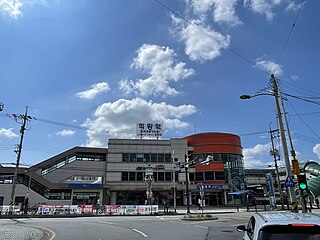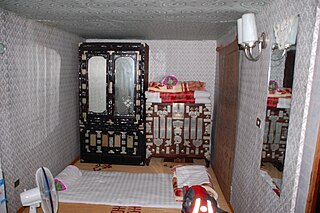Related Research Articles

The Suin Line was a metro line of the Seoul Metropolitan Subway serving the Seoul Capital Area.

Korea JoongAng Daily is the English edition of the South Korean national daily newspaper JoongAng Ilbo. The newspaper was first published on October 17, 2000, originally named as JoongAng Ilbo English Edition. It mainly carries news and feature stories by staff reporters, and some stories translated from the Korean language newspaper.

Uiwang Station is a ground-level metro station on line 1 of the Seoul Subway in Uiwang, South Korea. The station's four exits offer access to the Korea National University of Transportation, the Korean Railroad Museum and the Bugok Dong area of Uiwang. Travel time from Uiwang Station to Seoul Station on Line 1 is 50 minutes.

Artsonje Center is a private art museum in Seoul, Korea, located in Samcheong-dong, a neighborhood adjacent to known for its numerous art galleries, cafes, restaurants and boutiques. Founded in 1998, the museum introduces current and experimental contemporary art to the art world and public with its international exhibitions and educational programs.

Bukchon Art Museum (Korean: 북촌미술관) is an art museum in Seoul, South Korea. It has 150 pieces of Korean modern art, 200 pieces of Chinese art, 2500 of old documents of Joseon dynasty in total of 2850.
Global Village Folk Museum (Korean: 지구촌민속박물관) was a museum in Seoul, South Korea. It was located near the mountain Namsan. It opened on August 12, 2004, and closed permanently on November 30, 2016.
The Han Sang Soo Embroidery Museum is an art museum specializing in Korean embroidery located in Gahoe-dong, Jongno-gu, central of Seoul, South Korea. It was established by Han Sang Soo, who holds a title as a jasujang, a profession recognized as an Important Intangible Cultural Property by the Cultural Heritage Administration of South Korea.
Heojun Museum (Korean: 허준박물관) is a municipal museum in Gayang 2-dong, Gangseo-gu, Seoul, South Korea to commemorate the legacy of Heo Jun (1546–1615), a court physician during the reign of King Seonjo of the mid Joseon Dynasty of Korea.

The Kim Koo Museum is a museum in located within Hyochang Park, Hyochang-dong, Yongsan-gu, Seoul, South Korea. It commemorates the life and work of Kim Koo, a Korean independence activist during the Japanese occupation of Korea. It opened on October 22, 2002. It also contains a library.

The Kumho Museum of Art is an art museum in Seoul, South Korea.

The Leeum, Samsung Museum of Art is a museum in Hannam-dong, Yongsan District, Seoul, South Korea. It is run by the Samsung Foundation of Culture.

Seodaemun Museum of Natural History is a first public museum of natural history in South Korea, located in a metropolitan area, Seodaemun-gu, Seoul. It was founded in 2003 and operated by Seodaemun-gu Administration. The purpose of the foundation is to preserve, to study, and to exhibit geological and biological records about the local environment.

Tteok Museum is a museum located in Waryong-dong, Jongno-gu, Seoul, South Korea. Founded by Yoon Sookja, the chief director of the Institute of Traditional Korean Food (한국전통음식연구소), it opened in December, 2002. The museum specializes in Korean cutlery with approximately 2,000 old Korean kitchen utensils from ancient maetdol to early 20th century kitchenwares on display and exhibits 50 of Korea's nearly 200 types of tteok.

Sillim-dong (Korean: 신림동) is a dong (neighborhood) of Gwanak District, Seoul, South Korea. Seoul National University and Nokdu Street are located in the town. Its name means "new forest", which was derived from the woods outstretched from Mt. Gwanak. It consists 11 administrative neighbourhoods.

The Seoul Museum of Art (Korean: 서울시립미술관) is an art museum operated by Seoul City Council and located in central of Seoul, South Korea.
Sangam-dong is a legal dong (neighborhood) of the Mapo District in Seoul, South Korea. In the wake of the 2002 FIFA World Cup, a large apartment complex and DMC business district have been created and developed into the center of western Seoul.

The Kaesong Folk Hotel is a tourist hotel located in Kaesong, North Korea, which opened in 1989. Housed in 19 traditional hanok-style courtyard houses, many of which date to the Joseon dynasty and retain their original furnishings. The complex has 50 rooms, a traditional restaurant and a souvenir shop. The houses themselves are located on both sides of the stream that runs through Kaesong, with some located at the foot of Mountain Janam.
Seoul, the capital of South Korea, features a humid continental climate with dry winter, called "Dwa" in the Köppen climate classification, with four highly distinct seasons. In summer the influence of the North Pacific high-pressure system brings hot, humid weather with temperatures soaring as high as 35 °C (95 °F) on occasion. In winter the city is topographically influenced by expanding Siberian High-pressure zones and prevailing west winds, temperatures dropping almost as low as -20 °C (-4 °F) in severe cold waves. The bitterly cold days are commonly known to come in three-day cycles regulated by rising and falling pressure systems. The most pleasant seasons for most people in the city are spring and autumn, when azure skies and comfortable temperatures are typical. Most of Seoul's precipitation falls in the summer monsoon period between June and September, as a part of East Asian monsoon season.

Kapıkaya Canyon is a canyon located in Adana Province, southern Turkey.

USS LST-1010 was an LST-542-class tank landing ship in the United States Navy during World War II. She was transferred to the South Korean Navy as ROKS Un Bong (LST-807).
References
- ↑ "ImageRoot Museum - DXPIA" (in Korean). 2003-09-23. Retrieved 2024-04-25.